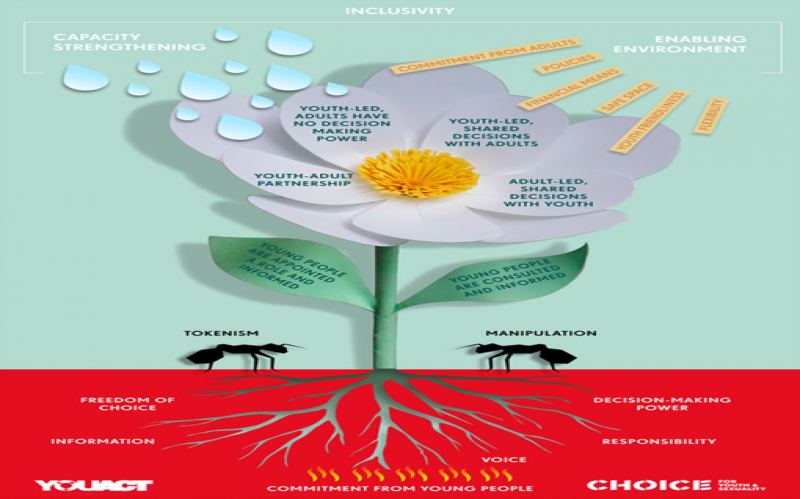A New Path Towards Institutionalizing Meaningful Youth Participation: How to Move from Promises to Practices
By: Pragya Singh, CHOICE for Youth and Sexuality and Ana Aguilera, EngenderHealth
Most organizations who work with and for young people strive to genuinely involve young people in their work—after all ‘nothing about us, without us’ is a slogan we’ve heard time and time again. This serves as a reminder that if you want programs and policies targeted at young people to work, you must have youth’s full and meaningful participation. Although the intention is usually there, organizations often struggle with putting this into practice and forget to ask the question: How can organizations translate meaningful youth participation from an ideal into practice?
In 2020, EngenderHealth and CHOICE for Youth and Sexuality (CHOICE), a global youth-led SRHR organization, entered into a unique Youth-Adult Partnership (YAP)[1] to answer that question. CHOICE supported EngenderHealth in enhancing our internal capacity to meaningfully work with adolescents and youth across our operations and programming. Now, six months later, we are sharing our aims, what we’ve learned thus far, and where we’re going next!

PAVING THE WAY FORWARD FOR STRONGER YOUTH-ADULT PARTNERSHIPS (YAPs)
EngenderHealth is committed to youth transformative change as a part of its cross-cutting focus on gender, youth, and social inclusion (GYSI) and CHOICE is a leading global expert in meaningful youth participation (MYP) as co-developers of the Flower of Youth Participation framework. Naturally, working together instead of in siloes made sense. So, with key interest and investment from the highest levels of our organizations, we co-developed a proposal which was funded by the William and Flora Hewlett Foundation. Through this initiative, CHOICE is providing targeted technical expertise to EngenderHealth to 1) systematically adopt the Flower of Participation into their operations and programs and 2) institute a formal accountability mechanism to monitor EngenderHealth’s progress over time to integrate MYP.
WALKING THE TALK: COMMITING TO MEANINGFUL YOUTH PARTNERSHIP
In some ways, the proposal development has been the easiest part of this process. Developing a partnership based on mutual respect and trust is always a learning curve but writing and imagining what could be is different from assessing what currently is and having hard conversations about what needs to change. Many organizations in our field talk about the importance of meaningfully engaging adolescents and youth but few genuinely commit and take an intentional approach to put this into practice at all levels.
CHOICE conducted a review of EngenderHealth’s organizational policies, carried out online surveys, and conducted focus group discussions with staff from different backgrounds and levels through a baseline assessment[2] process to understand young people’s perception of MYP and staff’s needs and ambitions towards integrating MYP within the organization. This was done by utilizing the Flower of Participation (FoP), a tool that uses the metaphor of a blooming flower to describe the different elements and forms of MYP and how MYP can grow and flourish.
Key findings highlight that there is no one solution in achieving the best form of MYP. Different contexts demand different solutions—the FoP can show you the way, but it is necessary to keep these differences in mind and set your own goals towards achieving MYP. For example, the focus group discussions highlighted how both young people and adults scored the presence of the core element of decision-making quite low when compared to other elements, especially information and freedom of choice, which scored high. But when looking at the presence of certain pre-conditions of MYP, there is an interesting discrepancy of results. For instance, country offices (including a mix of both youth and adults) in Asia scored the presence of safe space for young people low, citing cultural perceptions of youth-adult relationships and strong hierarchical societies. On the other hand, young staff (under 30) from different regions highlighted that while safe spaces for young people might exist, for them, it is the existence of concrete policies that enable youth participation, an area that needs more attention so that young staff are adequately supported and can learn and grow professionally within the organization.

Average highest and lowest scores of the pre-conditions of MYP, as scored by each group
More insights on MYP within EngenderHealth can be found in the summary report here.
KEY LESSONS WE’VE LEARNED SO FAR
- EngenderHealth: We learned about the importance of investing time and resources to build trust between adults and young people to counter power dynamics at play. Despite good intentions and clear expectations from the onset, it was important for EngenderHealth to check ourselves regularly and be open and honest about how we were sharing power amongst ourselves and with CHOICE when determining project objectives and negotiating activities, timelines, and budgets.
- CHOICE: As a youth-led organization, we were happy to see throughout our partnership with EngenderHealth that there is genuine interest within EngenderHealth to support and integrate MYP in their work, but they did not have much experience on how to go about this process. This is evidence that good intentions towards MYP exist within the organization and they can do the right thing if they have the know-how. CHOICE recognizes the need to contextualize CHOICE tools on MYP to suit the diversity of big, global, and diverse adult-led organizations. Furthermore, we recognize that working on SRHR and gender equality requires an intersectional lens, and therefore we have doubled down on our efforts to ensure all our tools are as inclusive of diverse audiences as possible.
- Joint Learning: CHOICE is an MYP expert and EngenderHealth is a global expert on SRHR and gender equality. This is an opportunity for both organizations to learn from each other and strengthen interventions that target young people in all their diversity. This includes addressing power dynamics, social norms, intersectionality, and inclusivity as well as common underlying factors that are necessary for both gender and youth transformative programs
NEXT STEPS: OPERATIONALIZING MYP WITHIN ENGENDERHEALTH
We know that no youth-adult partnership is perfect, but our hope is that throughout the course of 2021 we will continue to learn from each other, build on our strengths and expertise, challenge ourselves to create more inclusive virtual and physical spaces, and be honest about where we are making progress and where we are falling short. Stay tuned for more learnings and results from this partnership in the second half of 2021! In the meantime, we invite colleagues and organizations across our sector to share their experiences integrating MYP into their organizations and programs. What has worked for you? What have you learned along the way?
Share your thoughts on Twitter and tag @CHOICEforYouth and @EngenderHealth!
[1] A Youth-Adult Partnership is a partnership in which both young people and adults are equally involved and share power. They listen to each other, define the aims of the program or activity together, and share decision-making.
[2] A baseline assessment provides information on the situation the project wants to change. It establishes a basis for comparing the situation before and after the process starts, and for making inferences as to the effectiveness of the process. Baseline assessments should be conducted before the project starts and examined after the project has ended, to understand what changes took place due to implementing the project.




 Previous News article
Previous News article